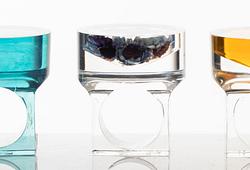Henry Moore
"Seven Studies for Standing and Seated Figures"
Signed Moore and dated -51. Pencil, wax and coloured crayon, watercolour wash and gouache on paper 29 x 23.7 cm. The work is registered at Henry Moore Foundation with archive number 2688 and is included in the Catalogue raisonné. A certificate issued May 2023 by Henry Moore Archive is included.
Import VAT
Import VAT (12%) will be charged on the hammer price on this lot. For further details please contact customer service +46 8-614 08 00.
Provenance
Arild Wahlstrøm, Norweigan art collector, (1909 - 1994).
Thence by descent to the present owner.
More information
Henry Moore created the auction's drawing of various figures in abstract forms in his sketchbook between 1950 and 1951. At this point in his career after World War II, Moore was considered the world's most significant modern sculptor. After exhibiting at the Venice Biennale in 1948, Moore played a prominent role in the Festival of Britain in 1951, where he became the first living artist to be portrayed in a film produced by the BBC, coinciding with his first major retrospective at Tate in London. The auction's drawing marks this period of success in Moore's life as well as his ability as a nuanced draftsman. After World War II, Moore often referenced his wartime anxiety in the fragile, fallen figures that populated his drawings and sculptures. In this drawing, Moore depicts various seated figures with truncated forms, reminiscent of the huddled figures in London's air-raid shelters and the bodies on the battlefield. The figures in this sketch specifically refer to Moore's sculptures from this period, such as "King and Queen" from 1952 (MOA Museum of Art, Atami; Middelheim Open Air Sculpture Museum, Antwerp) and "Family Group" from 1948-49 (Museum of Modern Art, New York; Tate Gallery, London). These drawings reveal Moore's experimental process as he studied the nature of forms and created new sculptural concepts. The figures in this drawing are rendered with Moore's characteristic technique, developed before the war and used in his evocative images of London's subway. By applying watercolor over layers of wax crayon, pen, and graphite, Moore enhanced the contrast between light and shadow to give depth and texture to his drawings.
Artist
Henry Moore (1898-1986) was a prominent British sculptor and artist who played a crucial role in the development of modern sculpture. His contributions to the art world are exceptional, and his works have had a lasting impact on art history.
Henry Moore was born in Castleford, Yorkshire, and showed an early passion for art. After serving in World War I, he studied at the Leeds School of Art and later at the Royal College of Art in London. It was here that he began exploring forms and materials that would define his artistic career.
Moore was strongly influenced by artists such as Pablo Picasso and Constantin Brancusi. He was also interested in non-Western art and sculpture traditions, particularly African and Oceanic art. These influences shaped Moore's unique style and his interest in exploring abstract forms and the representation of the human body.
One of the most prominent features of Moore's work is his fascination with the human figure. He experimented with abstracting and distorting the body to create sculptures that express a sense of movement, balance, and harmony. His sculptures often display rounded and organic forms, drawn from nature and the landscape around him.
Moore used a range of materials for his works, including stone, bronze, and wood. He was skilled at harnessing the properties of these materials, giving them a sense of life and movement. His sculptures often have a monumental scale and a presence that impacts the surrounding environment.
Throughout his career, Henry Moore also created many public artworks and monuments around the world. His works can be found in parks, museums, and urban environments worldwide, becoming icons of modern art. One example is his famous sculpture "Reclining Figure" (1951) located in The Art Institute of Chicago. This work has become a symbol of Moore's style and his contribution to the world of sculpture.
Henry Moore's influence extends far beyond his own work. He taught at several art institutions, inspiring an entire generation of young artists. His vision that sculpture can be both abstract and emotionally powerful continues to influence the art world.
Read more
























